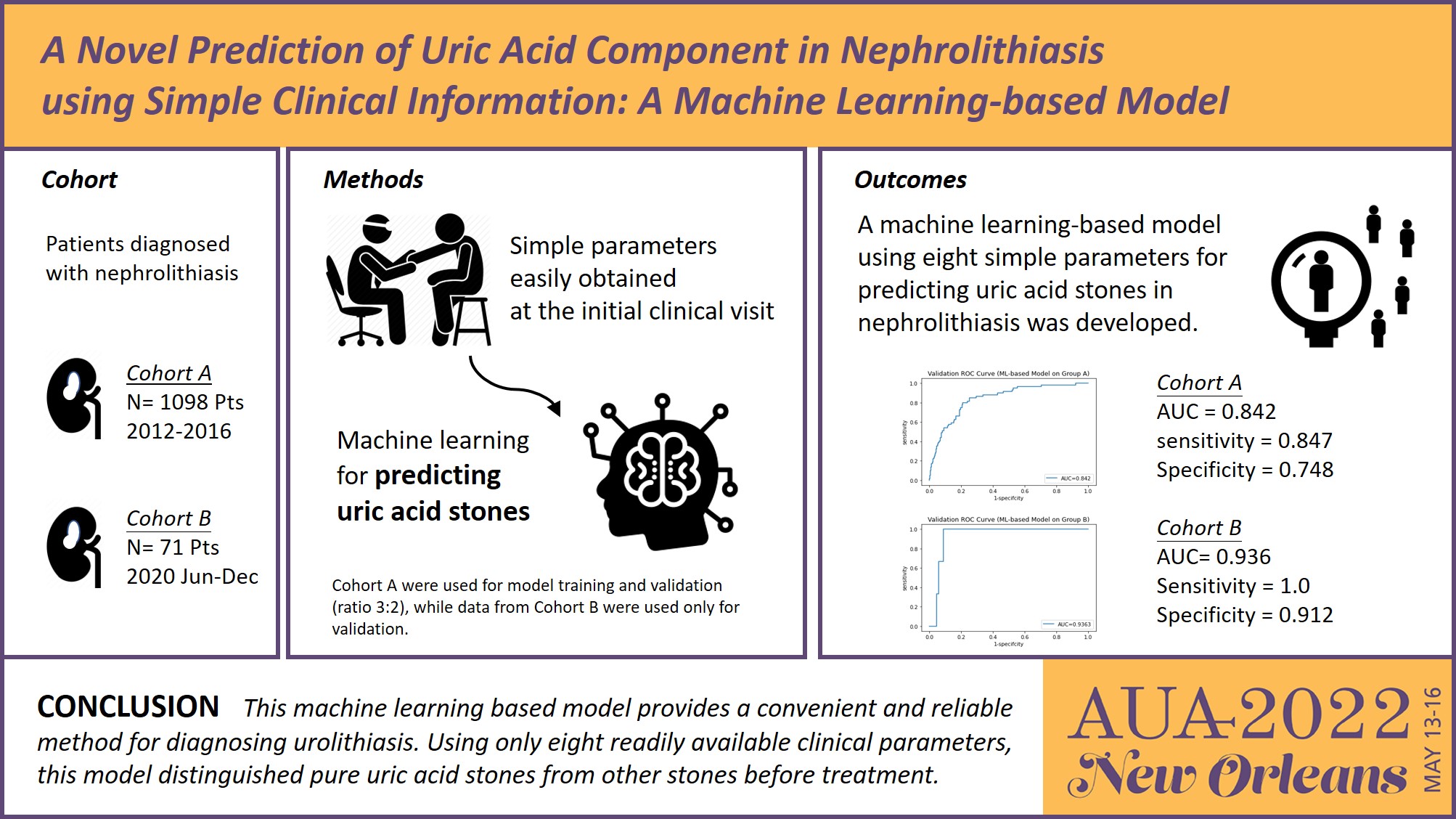Back
Poster, Podium & Video Sessions
Podium
PD50: Stone Disease: Epidemiology & Evaluation II
PD50-05: A Novel Prediction of Uric Acid Component in Nephrolithiasis using Simple Clinical Information: A Machine Learning-based model
Sunday, May 15, 2022
4:10 PM – 4:20 PM
Location: Room 255
Hao-Wei Chen*, Yu-Chen Chen, Jung-Ting Lee, Chung-Yao Kao, Wen-Jeng Wu, Yung-Shun Juan, Kaohsiung, Taiwan
- HC
Podium Presenter(s)
Introduction: A diagnostic tool for uric acid (UA) stones in nephrolithiasis using simple clinical information would be of great clinical use. We sought to build a predictive model for this purpose using machine learning (ML) methodologies based on simple parameters easily obtained at the initial clinical visit of the patient.
Methods: Socio-demographic, health, and clinical data of two cohorts (A and B), both diagnosed with nephrolithiasis, one between January 2012 and December 2016 and the other between June and December 2020, were collected before nephrolithiasis treatment. A mathematical model for predicting UA stones in nephrolithiasis was developed using ML methodologies entering only eight parameters
- sex, age, gout, diabetes mellitus, body mass index, estimated glomerular filtration rate, bacteriuria, and urine pH. Data from Cohort A were used for model training and validation (ratio of 3:2), while data from Cohort B were used for validation only.
Results: One hundred forty-six (13.3%) of 1098 patients in Cohort A and three (4.23%) of 71 patients in Cohort B had pure UA stones. For Cohort A, our model achieved validation AUC (area under ROC curve) of 0.8420, with 0.8475 sensitivity and 0.7480 specificity. For Cohort B, the model achieved 0.9363 AUC, 1.0 sensitivity, and 0.9118 specificity.
Conclusions: This ML-based model provides a convenient and reliable method for diagnosing urolithiasis. Using only eight readily available clinical parameters, this model distinguished pure uric acid stones from other stones before treatment.
Source of Funding: None.

Methods: Socio-demographic, health, and clinical data of two cohorts (A and B), both diagnosed with nephrolithiasis, one between January 2012 and December 2016 and the other between June and December 2020, were collected before nephrolithiasis treatment. A mathematical model for predicting UA stones in nephrolithiasis was developed using ML methodologies entering only eight parameters
- sex, age, gout, diabetes mellitus, body mass index, estimated glomerular filtration rate, bacteriuria, and urine pH. Data from Cohort A were used for model training and validation (ratio of 3:2), while data from Cohort B were used for validation only.
Results: One hundred forty-six (13.3%) of 1098 patients in Cohort A and three (4.23%) of 71 patients in Cohort B had pure UA stones. For Cohort A, our model achieved validation AUC (area under ROC curve) of 0.8420, with 0.8475 sensitivity and 0.7480 specificity. For Cohort B, the model achieved 0.9363 AUC, 1.0 sensitivity, and 0.9118 specificity.
Conclusions: This ML-based model provides a convenient and reliable method for diagnosing urolithiasis. Using only eight readily available clinical parameters, this model distinguished pure uric acid stones from other stones before treatment.
Source of Funding: None.


.jpg)
.jpg)